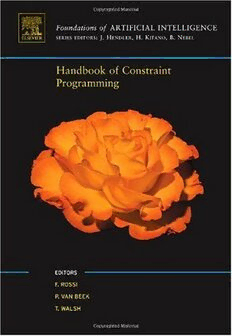Table Of ContentFOUNDATIONS OF
ARTIFICIAL INTELLIGENCE
Foundations of Artificial Intelligence
Series Editors
J. Hendler
H. Kitano
B. Nebel
Cover picture by Helmut Simonis
ELSEVIER
AMSTERDAM–BOSTON–HEIDELBERG–LONDON–NEW YORK–OXFORD
PARIS–SAN DIEGO–SAN FRANCISCO–SINGAPORE–SYDNEY–TOKYO
Handbook of Constraint Programming
Edited by
Francesca Rossi
University of Padova
Italy
Peter van Beek
University of Waterloo
Canada
Toby Walsh
National ICTA Australia &
University of New South Wales
Australia
ELSEVIER
AMSTERDAM–BOSTON–HEIDELBERG–LONDON–NEW YORK–OXFORD
PARIS–SAN DIEGO–SAN FRANCISCO–SINGAPORE–SYDNEY–TOKYO
Elsevier
Radarweg 29, PO Box 211, 1000 AE Amsterdam, The Netherlands
The Boulevard, Langford Lane, Kidlington, Oxford OX5 1GB, UK
First edition 2006
Copyright © 2006 Elsevier B.V. All rights reserved
No part of this publication may be reproduced, stored in a retrieval system
or transmitted in any form or by any means electronic, mechanical, photocopying,
recording or otherwise without the prior written permission of the publisher
Permissions may be sought directly from Elsevier’s Science & Technology Rights
Department in Oxford, UK: phone (+44) (0) 1865 843830; fax (+44) (0) 1865 853333;
email: [email protected]. Alternatively you can submit your request online by
visiting the Elsevier web site at http://elsevier.com/locate/permissions, and selecting
Obtaining permission to use Elsevier material
Notice
No responsibility is assumed by the publisher for any injury and/or damage to persons
or property as a matter of products liability, negligence or otherwise, or from any use
or operation of any methods, products, instructions or ideas contained in the material
herein. Because of rapid advances in the medical sciences, in particular, independent
verification of diagnoses and drug dosages should be made
Library of Congress Cataloging-in-Publication Data
A catalog record for this book is available from the Library of Congress
British Library Cataloguing in Publication Data
A catalogue record for this book is available from the British Library
ISBN-13: 978-0-444-52726-4
ISBN-10: 0-444-52726-5
ISSN: 1574-6525
For information on all Elsevier publications
visit our website at books.elsevier.com
Printed and bound in The Netherlands
06 07 08 09 10 10 9 8 7 6 5 4 3 2 1
Foreword
Constraints are an ubiquitous concept, which in its broader sense pertains to every day
experience: theyrepresenttheconditionswhichrestrictourfreedomofdecision. Infact,
howmuchourchoicesareconstrainedbytheexternalworldisabasicphilosophicalques-
tion. Intheformalizedreasoningofscientificdisciplines,constraintshavebeenemployed
extensively,fromlogictonumericalanalysis,frommathematicalprogrammingtoopera-
tionsresearch.Incomputerscience,constraintshavebeenwithusfromtheearlydays,for
modeling,representingandreasoning(seetheinterestinghistoricalremarksinChapter2
ofthishandbook,ConstraintSatisfaction:AnEmergingParadigm).
I see several good reasons for this ubiquity: one is the conceptually clear separation
betweentheperfectlydeclarativeproblemstatementsandtheoftencumbersomeenumera-
tiveeffortsforfindingsolutions.Anotherreasonisthecomplexitychallenge:theclassical
constraint satisfaction problem is NP-complete and in fact tautology checking in propo-
sitionalcalculus(aconstraintproblemonBooleanvariables)hasbeenthetouchstonefor
this complexity class. A further reason is that large, complex constraint problems often
occurinpractice,theymustbesolvedinonewayoranother,andfast,efficient,systematic
solutionshaveanenormouseconomicvalue.
WhatIfindsurprisingaboutconstraintsisthatwithinartificialintelligenceandcom-
putersciencearelativelyrecent,relativelyuniformbodyofknowledgehasemergedwhich
often yields decisive advantages over classical, extensively studied and well developed
techniques. Asformanysuccessstorieswithincomputerscience, successislargely due
toamixtureofstructures,algorithms,languages,programmingtechniquesandsystemim-
plementations. The aim of this handbook is to present this knowledge in all its facets.
Differentchaptersarelargelyselfcontainedandallcontributetoputthesubjectintofocus,
similarlytotheHawaiiKeckobservatory,wherethemirroriscomposedof36hexagonal
segments.
Fromtheconceptualpointofview,themaincharacteristicfeaturesofconstraintpro-
grammingareconstraintpropagation,andtheidentificationofvariousspecialcaseswhich
make complexity tractable. The former (see Chapter 3) is an inference technique which
makeslocalconstraintsstrongerwithout changingtheglobalconstraint. The latterissue
concernsboththestructure(seeChapter7,TractableStructuresforConstraintSatisfaction
Problems)andthekindofconstraints(seeChapter8,TheComplexityofConstraintLan-
guages). Lessspecific,butstillveryimportantissuesareasfollows: BacktrackingSearch
Algorithms, in Chapter4; LocalSearch, in Chapter 5; Global Constraints, in Chapter6;
SymmetryinConstraintProgramming,inChapter10;andModelling,inChapter11.
Anothersurprisingfactaboutconstrainttheoryistheincrediblycloserelationshipwith
logicprogramming. Inaratherprecisesenselogicprogrammingisawayofexpressing,
andsolving, certainclassesofdisjunctive,recursiveconstraints. Furthermore, logicpro-
grammingcanbeveryelegantlygeneralizedtoconstraintlogicprogramming(seeChapter
v
vi Foreword
12),wheretheordinaryHerbrandconstraintsystem,anditsunificationalgorithm,arecom-
plementedwithspecificconstraintsolvers.Theinteractionwiththecommittedchoicelan-
guagesstudiedintheJapaneseprojectsoftheeightiesalsoyieldedveryinterestingmodels
ofcomputationbasedonconstraints. Amalgamationwithmorecommon(andefficiently
implemented!) programming languages is also possible (see Chapter 13, Constraints in
ProceduralandConcurrentLanguages).
Besidesandbeyondthebeautyofitstheoreticalfoundations,whatcontributesthemost
tothepracticalconvenienceofconstraintprogrammingare:(i)thedevelopmentofspecific
resultsforimportantclassesofconstraints;(ii)theabilityofextendingthebasictheoryto
variousadditionalaspectswhichareveryrelevantinpractice; and(iii)theflexibilityand
potentialforintegrationwithothermodelingandsolvingmethodologies.
Aboutthedevelopmentofspecificresults,thishandbookincludeschaptersaboutcon-
straintsonfinite(Chapter14),structured(Chapter17),temporal(Chapter19),continuous
andinterval-based(Chapter16)domains. Thepotentialtoextendthebasictheoryinevi-
dentinthecaseofsoftconstraints,consideredinChapter9.Ordinaryconstraintsareeither
satisfied or not, namely either true or false. Instead soft constraints return a more infor-
mativeweight. Interestinglyenough,theproposedextensionsbothaccommodateseveral
important cases(fuzzy, hierarchical, optimization, probabilistic constraints), and still of-
tenexhibitessentiallythesamesolutionalgorithms. Extensionstorandom,changingand
distributed/openconstraintsaretreatedinChapters18,21and20respectively.
Aboutthelastissue,inadditiontotheseamlessintegrationwithlogicandimperative
programminglanguageswementionedalready,quiteremarkablearetheparadigmsresult-
ingfromtheintegrationofconstraintprogrammingwithoperationsresearch(seeChapter
15),withschedulingandplanning(seeChapter22),withvehiclerouting(seeChapter23),
withcomponentconfiguration(seeChapter24),with(electricity,water,oil,data)networks
(seeChapter25),andwithbioinformatics(seeChapter26).
The global scenario based on service-oriented computing which is now under devel-
opment offers additional theoretical and practical challenges to constraint programming.
Conditionsforservicedeploymentanddiscovery,bothfunctionalandinvolvingdifferent
aspectsofqualityofservice,couldbeexpressedintermsofhardandsoftconstraints,and
thenegotiationphasesshouldinvolvesubstantialconstraintsolvingabilities. Transactions
among the various actors could also require partially backtrackable behavior or at least
programmablecompensations.Somelevelofrealtime,distributed,globalconstraintsolv-
ingshouldbeimplementedinthemiddleware,sincelotsofhigherlevelapplicationswill
beabletotakeadvantageof,andpayforit.
Ithinkthatresearchandpracticaldevelopmentintheareaofconstraintprogramming
willbeveryactiveforquiteawhileinthefuture,establishingcloserandcloserconnections
with a variety of other design methodologies and even other disciplines. I consider this
handbooknotonlyaverynicepieceofscientificwork,butalsoacontributionquiteinstru-
mental at disseminating advanced knowledge about constraint programming both within
theinnerconstraintcommunityandacrossthemuchwideraudienceofpotentialusers.
UGOMONTANARI
DipartimentodiInformatica
Universita`diPisa,Italy
Editors
FrancescaRossi
UniversityofPadova
Italy
PetervanBeek
UniversityofWaterloo
Canada
TobyWalsh
NationalICTAustralia&
UniversityofNewSouthWales
Australia
vii
This page intentionally left blank
Contributors
RolfBackofen EugeneC.Freuder
Albert-Ludwigs-Universita¨t CorkConstraintComputationCentre&
Germany UniversityCollegeCork,Ireland
PhilippeBaptiste ThomFru¨hwirth
CNRSLIX&E´colePolytechnique Universita¨tUlm
France Germany
Fre´de´ricBenhamou IanP.Gent
Universite´deNantes UniversityofSt.Andrews
France Scotland,UnitedKingdom
ChristianBessiere CarmenGervet
LIRMM-CNRS BrownUniversity
France USA
KennethN.Brown DavidGilbert
CorkConstraintComputationCentre& UniversityofGlasgow
UniversityCollegeCork,Ireland Scotland,UnitedKingdom
MatsCarlsson CarlaGomes
SICSAB CornellUniversity
Sweden USA
DavidCohen LaurentGranvilliers
RoyalHolloway,UniversityofLondon Universite´deNantes
UnitedKingdom France
RinaDechter JohnN.Hooker
UniversityofCalifornia,Irvine CarnegieMellonUniversity
USA USA
BoiFaltings HolgerH.Hoos
SwissFederalInstituteofTechnology UniversityofBritishColumbia
Switzerland Canada
ix

